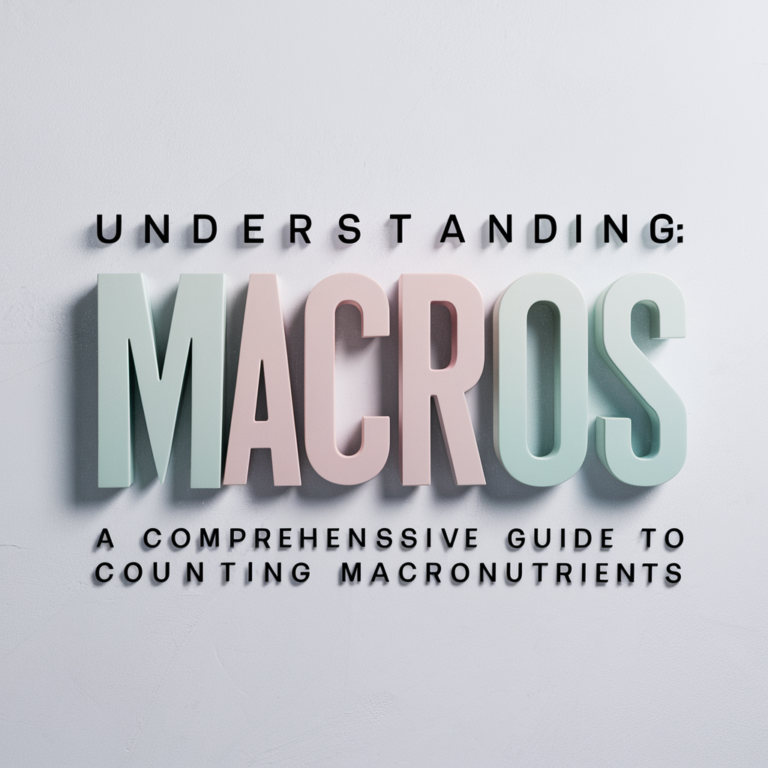Understanding Macros: A Comprehensive Guide to Counting Macronutrients
In the ever-evolving world of nutrition and fitness, one concept has gained significant traction: macro counting. This detailed guide will demystify macronutrients, explain their crucial role in your diet, and provide you with the knowledge and tools to effectively count macros for optimal health and fitness results.
What Are Macronutrients?
Macronutrients, commonly referred to as “macros,” are the three primary categories of nutrients that provide energy (calories) and form the foundation of our diet. Each plays a unique and vital role in our body’s functions:
1. Protein
Often called the building blocks of life, proteins are essential for:
- Building and repairing tissues
- Producing enzymes and hormones
- Supporting immune function
- Maintaining fluid balance
Energy Content: 4 calories per gram
Sources: Meat, fish, eggs, dairy, legumes, and some grains
Protein Fact:
The body can’t store protein like it can carbs and fats. This is why consistent protein intake throughout the day is crucial for muscle maintenance and growth.
2. Carbohydrates
Carbs are the body’s preferred energy source, crucial for:
- Fueling brain function
- Providing energy for physical activities
- Sparing protein for tissue repair and growth
- Facilitating fat metabolism
Energy Content: 4 calories per gram
Sources: Fruits, vegetables, grains, and legumes
Carb Fact:
Not all carbs are created equal. Complex carbohydrates (like those found in whole grains and vegetables) provide sustained energy and are rich in fiber, while simple carbs (like those in sugary snacks) can cause rapid spikes in blood sugar.
3. Fats
Despite their bad reputation in the past, fats are crucial for:
- Hormone production
- Nutrient absorption (especially fat-soluble vitamins A, D, E, and K)
- Providing a concentrated source of energy
- Insulating and protecting organs
Energy Content: 9 calories per gram
Sources: Oils, nuts, seeds, avocados, and fatty fish
Fat Fact:
Omega-3 fatty acids, found in fatty fish like salmon and sardines, have been shown to have anti-inflammatory properties and may help reduce the risk of heart disease.
The Science Behind Macro Counting
Macro counting is based on the principle that the composition of your diet, not just the total calorie intake, plays a significant role in health and body composition. This approach, also known as flexible dieting or “If It Fits Your Macros” (IIFYM), allows for a more nuanced understanding of nutrition compared to simple calorie counting.
Historical Context:
The concept of counting macronutrients gained popularity in the bodybuilding community in the 1980s but has since become mainstream with the rise of fitness tracking apps and wearable technology.
Benefits of Counting Macros
- Precision: Allows for fine-tuning of diet based on individual needs and goals
- Flexibility: Permits a wider variety of foods while still meeting nutritional targets
- Body Composition: Can be more effective for improving body composition than calorie counting alone
- Performance: Enables optimization of diet for athletic performance
- Education: Increases awareness of food composition and nutritional value
How to Calculate Your Macro Needs
Determining your ideal macro ratio is a personalized process that depends on various factors:
- Age
- Gender
- Height and weight
- Activity level
- Body composition
- Specific fitness goals
While there’s no one-size-fits-all approach, here’s a general guideline to start with:
| Goal | Protein | Carbohydrates | Fats |
|---|---|---|---|
| Weight Loss | 30-35% | 35-40% | 25-30% |
| Maintenance | 25-30% | 45-50% | 25-30% |
| Muscle Gain | 30-35% | 45-50% | 20-25% |
Advanced Macro Calculator
Use this calculator to get a more personalized macro breakdown based on your specific goals and activity level:
Implementing Macro Counting in Your Daily Life
Steps to Count Macros
- Determine your calorie needs: Use the calculator above or consult a nutritionist to find your Total Daily Energy Expenditure (TDEE).
- Set your macro ratios: Based on your goals, choose appropriate percentages for each macronutrient.
- Calculate your macro grams: Convert the percentages to grams based on your calorie goal.
- Track your food intake: Use a food scale and a tracking app to log everything you eat and drink.
- Adjust as needed: Monitor your progress and adjust your macros if you’re not seeing desired results.
Pro Tip:
When starting out, focus on hitting your protein target first. Adequate protein intake is crucial for muscle maintenance and satiety, especially when in a calorie deficit.
Tools for Macro Tracking
- Food Scale: Essential for accurate portion measurement
- Smartphone Apps: MyFitnessPal, LoseIt, or MyMacros+ for easy food logging
- Meal Prep Containers: Help with portion control and pre-planning meals
- Nutrition Labels: Learn to read and understand food labels for accurate tracking
Common Challenges and Solutions
| Challenge | Solution |
|---|---|
| Eating Out | Research restaurant nutrition info in advance, or estimate portions and log best guesses |
| Social Events | Plan macros around events, or practice moderation and get back on track the next day |
| Hitting Protein Targets | Incorporate protein-rich snacks, consider protein supplements if needed |
| Balancing Fats | Focus on healthy fat sources, be mindful of portion sizes for calorie-dense foods |
| Tracking Fatigue | Take periodic breaks, or transition to a more relaxed approach like focusing on protein and portion control |
Advanced Tips for Macro Counting Success
- Nutrient Timing: Consider adjusting macro intake around workouts for optimal performance and recovery
- Fiber Focus: Aim for 25-30g of fiber daily for digestive health and satiety
- Micronutrient Awareness: Use a tracking app that shows vitamin and mineral content to ensure balanced nutrition
- Meal Templating: Create go-to meal templates that fit your macros for easy planning
- Periodic Refeed Days: For those in a prolonged deficit, consider higher carb days to replenish glycogen and boost metabolism
- Track Trends: Look at weekly averages rather than stressing over daily perfection
The Role of Macros in Different Diets
Understanding how macros fit into various popular diets can help you make informed decisions about your nutritional approach:
- Ketogenic Diet: Very low carb (5-10%), high fat (70-75%), moderate protein (20-25%)
- Paleo Diet: Moderate carb (20-40%), moderate fat (30-40%), high protein (20-35%)
- Mediterranean Diet: Moderate carb (40-50%), moderate fat (30-40%), moderate protein (15-25%)
- Vegan Diet: Can vary, but often higher carb (50-60%), moderate fat (20-30%), moderate protein (15-20%)
Diet Flexibility:
Macro counting can be adapted to fit within the framework of many different dietary approaches, allowing for personalization while maintaining the principles of specific diets.
Frequently Asked Questions
Q: Is it necessary to hit my macro targets exactly every day?
A: While consistency is key, perfection isn’t necessary. Aim to get within 5-10% of your targets daily, and focus more on your weekly average. This approach allows for flexibility and reduces stress around tracking.
Q: Can I eat any foods as long as they fit my macros?
A: While macro counting does offer flexibility, the quality of your food choices still matters. Aim for 80-90% of your diet to come from nutrient-dense, whole foods. This ensures you’re getting essential micronutrients and fiber, which are crucial for overall health and aren’t accounted for in macro tracking alone.
Q: How long should I count macros?
A: The duration depends on your goals and preferences. Some people count macros long-term as a lifestyle choice, while others use it as a short-term tool to learn about portion sizes and food composition. It’s perfectly fine to take breaks or transition to a more intuitive eating style once you’ve gained a solid understanding of your nutritional needs.
Q: Should I adjust my macros on workout days?
A: This practice, known as carb cycling, can be beneficial for some individuals, especially athletes or those with specific body composition goals. It typically involves increasing carbohydrates on workout days and decreasing them on rest days. However, it’s not necessary for everyone and can add complexity to tracking. If you’re interested in this approach, consider working with a nutritionist to develop a personalized plan.
Q: What about micronutrients?
A: While macro counting focuses on protein, carbs, and fats, it’s crucial not to neglect micronutrients (vitamins and minerals). Ensure you’re eating a variety of fruits, vegetables, and whole foods to meet your micronutrient needs. Some tracking apps also show micronutrient breakdowns, which can be helpful. If you’re concerned about deficiencies, consider tracking your micronutrients periodically or speaking with a healthcare professional about supplementation.
Q: Can macro counting help with specific health conditions?
A: Macro counting can be adapted to support various health conditions. For example, individuals with diabetes might focus on controlling carbohydrate intake, while those with kidney issues might need to monitor protein. However, it’s crucial to work with a healthcare provider or registered dietitian to develop a macro plan that’s appropriate for your specific health needs.
Conclusion
Macro counting is a powerful tool that can help you optimize your nutrition for better health, performance, and body composition. By understanding the role of each macronutrient and learning how to balance them in your diet, you can take control of your nutrition in a way that’s both flexible and precise.
Remember, while tracking macros can be highly effective, it’s just one approach to nutrition. The most important factors for long-term health and fitness are consistency, choosing nutrient-dense foods most of the time, and finding an approach that’s sustainable for your lifestyle.
As you embark on your macro counting journey, be patient with yourself and willing to adjust your approach as you learn more about your body’s needs. And as always, for personalized advice, especially if you have specific health concerns or athletic goals, consult with a registered dietitian or healthcare professional.
Final Tip:
Use macro counting as a learning tool. Over time, you’ll develop a better intuitive understanding of portion sizes and food composition, which can help you make informed choices even when you’re not actively tracking.

